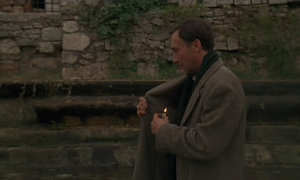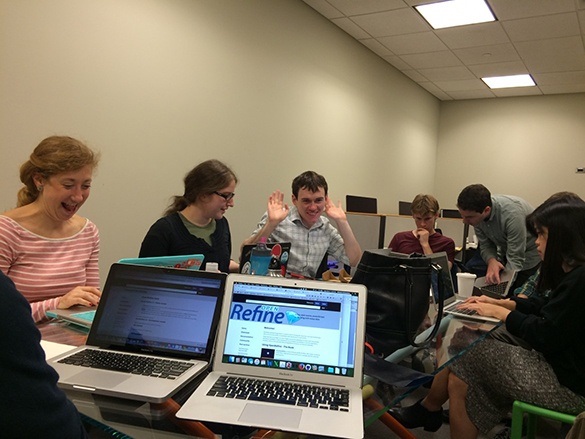This is a sort of two-pronged post, addressing Matt’s question towards the end of last class, re: how the readings / class discussions are helping me think more about my data (or final) project.
I’m really interested in the ideas and examples of “deformance” (in Jerome McGann’s definition = interpretation + performance) that have come up recently, especially and most recently in Lev Manovich & Kevin’s digital work. I suppose I think of “deformance” as a way of turning art into new art… the purpose of which is beyond just “playing around” and being creative (good purpose in itself), but also, as Kevin pointed out, to ask questions of the “data” (the art, or the world in which it was produced) that you wouldn’t have known to ask before. Disordering the work of art (text, photo, or film) in order to change its questions, its answers, its “rules.” I have also been interested in the way that digital “deformance” tends to “aesthetically pleasing” results – Kevin and Lev’s work simply “look good,” and I’d love if one my projects in this course (i.e., project fully executed) could aspire to that type of artistic attention (which seems to derive from direct intention + skills + a level of pure play or “accident”).
Along these lines, it is now my intention to do a “deformance” project that is focused on my own writing / creative process. That is, rather than trying to uncover and work with the huge and somewhat impossibly impenetrable “data set” I previously proposed (Appropriation in Contemporary Poetry), I would like to either:
- 1 – Make a digital hypertext edition of my book manuscript (Babette, recently published in print this month), adding one or more layers of text to discover more information about the language on the page. This may include anecdotes, links, or perhaps even other “poems,” that seem to enrich, deconstruct, or disorder the present text. Thus the “data set” would be the original text (+ the new text?) I would like this hypertext edition to move the reader away from the “search” (for meaning) and towards the “browse” function, revealing both writing and reading as dynamic, non-linear, and layered, with interconnected information and experiences. On that note, a final goal would be to open the text to “community, relationship, and play” (Stephen Ramsay) by allowing “users” to add their own interpretations, experiences, links, etc. (though I understand this might be beyond the scope of this project).
OR
- 2 – Create a digital hyper-text edition of my three published manuscripts (Babette, Parades, and Latronic Strag) and do a data-visualization of the neologisms I’ve used in these works. The “data set” would thus be these “neologistic” words, about which I could ask starting questions such as: “how often do they appear in each book,” “how much do they sound like one another,” “how closely are they “related” to each other (by the computer’s definition),” how closely are they “related” to “real” words, what words do these associate with in my mind (or the computer’s, or in the minds of other readers)… what “real” language do they sound like, and is there some sort of “neologistic” conversation going on between the words, phrases, poems, manuscripts? Again, the aim would be to use the language as data to “browse” for new questions about the text, rather than “search” for these answers, and one ultimate goal would be to have the project allow for “users” to add in their own experience of these words (creating more data).
Allowing others to add reactions, data, or personal experience is one way for me to get away from the fear that this would be a “vanity project” (in which the data in the set is simply my own data). Another way would be to see this project as a starting point for hypertext-ing or disordering other texts, texts that are not my own. Perhaps I see this project as one that might move me closer to that more “research”-like or scholarly question of how language is appropriated or repurposed in contemporary poetry.
As for creating a “digital edition” of one (or more) of my books, I found a tool called Ediarum on the DIRT site, which claims to help authors “transcribe, encode, and edit” manuscripts.
As for the second (and I’d imagine, more fun and elaborate) task of “hypertexting” the book(s), I had to do a little more research to see what’s out there, and where it’s coming from. What “kind” of hypertext am I looking to produce? Based on the Wikipedia definitions of “forms of hypertexts,” I’d surely like to create something that is “networked,” i.e. “an interconnected system of nodes with no dominant axis of orientation… no designated beginning or designated ending.” And, if I wanted to be able to add that user interaction, I’d want something “layered”: a structure with two layers of linked pages in which readers could insert data of their own.
Searching for tools to create networked / layered hypertext lead me to two options on DIRT: Mozilla Thimble, and TiddlyWiki. (It also lead me to investigate what software is or has been available for hypertext, starting with Ted Nelson’s ProjectXanadu, and ending, it seems, with the popular (and expensive, at $300) program from Eastgate called StorySpace, neither of which I think will be very helpful).
I’d love any thoughts on which project (1 or 2) seems more interesting, appropriate, or feasible for this project… I’m going to make an appointment with the Digital Fellows to get their advice (and guidance on the tools).
Thanks!
– Sara




